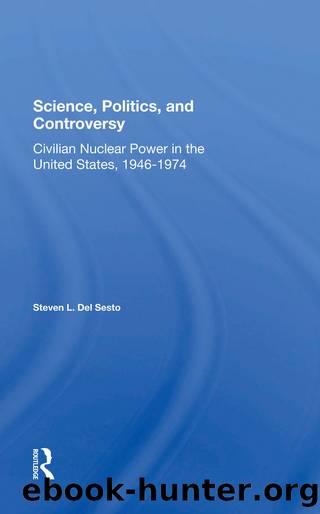Science, Politics, And Controversy by Stephen L Del Sesto

Author:Stephen L Del Sesto [Sesto, Stephen L Del]
Language: eng
Format: epub
ISBN: 9781000310863
Barnesnoble:
Publisher: Taylor & Francis
Published: 2019-06-26T00:00:00+00:00
Power Projections, the Political Climate, and Citizen Opposition
The first few years after the enactment of the public participation clause saw a significant lack of organized citizen action. Apart from the more substantial opposition at Bodega Bay, Malibu, and Ravenswood facilities, most of the initial opposition via the public hearing was generally rather unorganized, and assumed the form of a town meeting where concerned citizens would simply meet with and question AEC and utility representatives.12 However, several new developments were in the air during this time, and increased citizen involvement seemed eminent.
Perhaps most important in heightening citizen participation were the AEC's hefty power projections, particularly the anticipated role of nuclear power in the United States energy mix for the remainder of the century. As shown previously, the Commission was extremely optimistic about the future of nuclear energy. In the Commission's Report to the President in 1962, for example, the following statements were made:13
Nuclear energy can and should make an important and, ultimately, a vital contribution toward meeting our long-term energy requirements, and, in particular, that: the development and exploitation of nuclear electric power is clearly in the near- and long-term national interest and should be vigorously pursued.
Furthermore, the Commission's 1967 Supplement to the 1962 report concluded that:14
Total energy consumption is expected to increase by 50 percent between 1965 and 1980 and by 150 percent between 1965 and 2000... The proportion of energy consumed in the form of electricity is currently about 20 percent; it is expected to increase to 30 percent in 1980 and tb over 50 percent by the year 2000... Whereas less than 1 percent of the electrical generating capacity in 1965 was nuclear, it is estimated that 23 to 30 percent will be nuclear in 1980 and about 50 percent in 2000.
Seemingly in concert with AEC's 1967 projections the President's Office of Science and Technology reported in 1968 that at existing rates of consumption, at least 492 new electrical generating stations would be required by 1990.15 it was thus not entirely surprising to find nuclear power stations proliferating at an accelerated rate, as applications for construction of nuclear units reached an all-time high in 1967, when the AEC received twenty-nine new applications for construction permits, while at the same time, issuing twenty-three construction permits on pending applications.16 With the AEC's goal for nuclear generating stations being to produce about fifty percent of the nation's electricity by the year 2000, it seemed likely that about 1,000 nation-wide nuclear stations would be required to generate this much power.17
The rather weak and unorganized anti-nuclear forces naturally found the above scenario rather shocking. On the one hand, the nation seemed on the verge of a crash nuclear development program--a thousand reactors by the year 2000--yet on the other hand, the safety of the reactors had not been convincingly proved. Indeed, the AEC's 1957 safety study, WASH-740 (Theoretical Consequences of Major Accidents in Large Nuclear Power Plants), had not yet received any substantial up-date. As WASH-740 indicated in 1957, a major reactor accident
Download
This site does not store any files on its server. We only index and link to content provided by other sites. Please contact the content providers to delete copyright contents if any and email us, we'll remove relevant links or contents immediately.
| Alternative & Renewable | Drilling Procedures |
| Electric | Fossil Fuels |
| Mining | Nuclear |
| Power Systems |
Whiskies Galore by Ian Buxton(40511)
Introduction to Aircraft Design (Cambridge Aerospace Series) by John P. Fielding(32348)
Small Unmanned Fixed-wing Aircraft Design by Andrew J. Keane Andras Sobester James P. Scanlan & András Sóbester & James P. Scanlan(32148)
Craft Beer for the Homebrewer by Michael Agnew(17463)
Turbulence by E. J. Noyes(7059)
The Complete Stick Figure Physics Tutorials by Allen Sarah(6649)
Kaplan MCAT General Chemistry Review by Kaplan(6066)
The Thirst by Nesbo Jo(5794)
Bad Blood by John Carreyrou(5782)
Learning SQL by Alan Beaulieu(5425)
Weapons of Math Destruction by Cathy O'Neil(5048)
Man-made Catastrophes and Risk Information Concealment by Dmitry Chernov & Didier Sornette(4749)
iGen by Jean M. Twenge(4708)
Digital Minimalism by Cal Newport;(4569)
Life 3.0: Being Human in the Age of Artificial Intelligence by Tegmark Max(4520)
Audition by Ryu Murakami(4107)
1,001 ASVAB Practice Questions For Dummies by Powers Rod(4046)
Electronic Devices & Circuits by Jacob Millman & Christos C. Halkias(4043)
Pale Blue Dot by Carl Sagan(4017)
